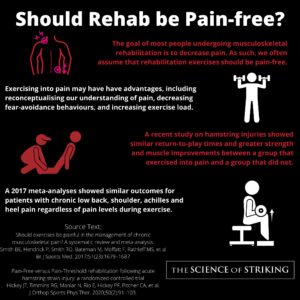The rehabilitation of musculoskeletal conditions is a multi-faceted process that needs to be tailored to the individual patient and needs to take into account personal factors as well as address all relevant contributing factors to the condition. As the primary goal of most patients undergoing rehabilitation is to decrease pain levels, it appears logical that the modalities and intervention utilised should therefore be pain-free. There has been a notion present amongst healthcare providers, as well as researchers, that the presence of pain during rehabilitation may impede the long-term reduction of pain, through increased sensitivity of the peripheral and central nervous systems, excessive local tissue stress, and secondary alterations in movement patterns and behaviours.
However, previous research has shown that changes to psychological factors, self-efficacy and depression are strong predictors of treatment outcomes, mediated by changes in patients pain catastrophising and physical activity (1), and as pain rarely correlates with tissue damage, it has been proposed that loading and resistance programmes that temporarily reproduce and aggravate a patient’s symptoms may be more effective that those that fail to achieve this, by facilitating a reconceptualisation of pain, and addressing fear avoidance and pain catastrophising beliefs.
A 2017 systematic review by Smith and colleagues looked at 9 studies investigating the effectiveness of treatment interventions exercising into pain compared to not exercising into pain (2). Conditions treated in these studies included low back pain, shoulder pain, achilles pain and plantar heel pain. Patients across these studies were instructed to exercise to a tolerable level of pain, and symptoms had to recover within a certain period of time (usually 24-48 hours). Those groups exercising into pain demonstrated superior clinical outcomes in the short and medium term, however in the long-term there was no statistically significant difference between them.
Exercise in general has reliably been shown to decrease musculoskeletal pain through what is termed exercise-induced hypoalgesia, a process that is thought to involve the release of endogenous opioids and activation of spinal inhibitory mechanisms (3). Exercising into pain is thought to change the output of pain through neuromodulatory mechanisms, and may have a strong psychological effect through decreasing fear avoidance and catastrophising. We also know that there is a considerable dose-response effect when it comes to exercise and pain, and it may be that allowing a patient to exercise into pain will likely allow a greater dose of exercise to be applied, leading to superior physiological adaptations.
Similar findings have also been reported in acute injuries. A recent study by Hikey et. al. looked at the effect of training into pain on return to sport time in 42 elite athletes recovering from acute hamstring injury (4). Conventional rehabilitation for muscular strains has typically avoided working into pain, however these guidelines have not been based on sound scientific evidence. This study compared rehabilitation outcomes between one group who performed their rehabilitation exercises with a pain rating of 0 on a numerical scale and another group who performed their exercises with a pain rating of between 1 and 4 out of 10. They found that return to play times and fear of movement scales were no different between the two groups, however at the 2-month follow-up, biceps femoris long head fascicle length and isometric knee flexion strength outcomes were superior in the group that exercised into pain.
There is still much work to be done in this space and future studies need to more clearly define the measurements of pain, however it appears promising that pain during the rehabilitation process is unlikely to be a negative factor in terms of long-term clinical outcomes. This is advantageous to us as clinicians, as it gives us confidence to educate our patients that moderate levels of pain with exercise should not be a barrier to treatment. Likewise, if a patient is uncomfortable working into pain then their outcomes are likely to be similar if they avoid pain with their exercises.
Obviously this approach needs to be condition and individual-specific. There are some conditions (e.g. body stress injuries) where a pain-free approach is likely advantageous, and others (e.g. tendinopathies) where higher pain levels are now an accepted pain of common treatment paradigms. There are also likely to be patient personality types who do well with a more painful rehabilitation and others who do not. This is where the thorough assessment and sound clinical reasoning is of paramount importance.
References
- Miles CL, Pincus T, Carnes D, Homer KE, Taylor SJ, Bremner SA, et al. Can we identify how programmes aimed at promoting self-management in musculoskeletal pain work and who benefits? A systematic review of sub-group analysis within RCTs. Eur J Pain. 2011;15(8):775–e1.
- Smith BE, Hendrick P, Smith TO, Bateman M, Moffatt F, Rathleff MS, et al. Should exercises be painful in the management of chronic musculoskeletal pain? A systematic review and meta-analysis. Br J Sports Med. 2017;51(23):1679–1687.
- Koltyn KF. Analgesia following exercise. Sports Med. 2000;29(2):85–98.
